Sterile prevention of primary culture of organoids and sterilization of cells (2)
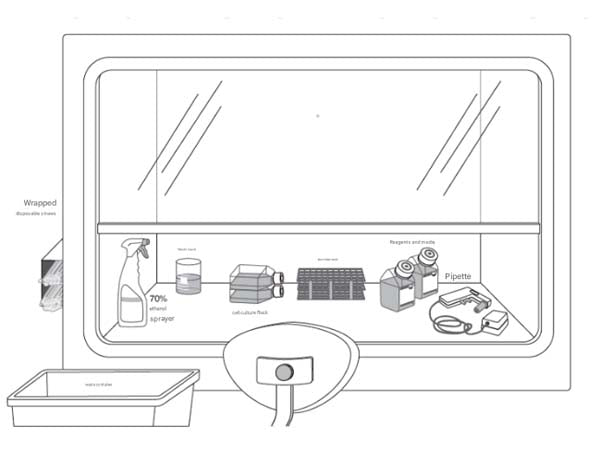
1. Overview
Organoid contamination is a common thing, especially in the gastrointestinal tract, the number of microflora brought by the tissue itself is very large, and once the disinfection is not in place, it will lead to the failure of organoid culture. In the last issue, we learned the identification and sterilization strategy of organoid contamination (1), and then Xiaoai will take you to understand the sterile prevention of primary culture of organoids and the sterilization scheme of cell loll (2).
2. Sterility prevention of primary culture
1. Prevent all aspects of aseptic
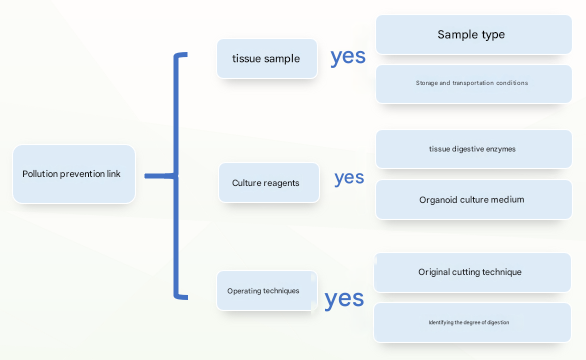
2. Sampling and storage for sterility prevention
Pay attention to sterility:
1) To prevent contamination, 1% bispecific antibody (ABS9244) can be added to the tissue preservation solution (ABS9784);
2) The volume of tissue preservation fluid should be able to submerge the whole tissue, generally 5-10mL;
3) The sampling bottle should be sterile, and a 15mL or 50mL sterile centrifuge tube can also be used as a sampling tube;
4) Place the tissue with tweezers sterilized with an alcohol cotton and place the tissue into a sampling bottle containing the tissue preservation solution;
5) The surgically excised tissue should be immediately transferred to a sterile sampling bottle containing tissue preservation solution.
Storage and transport conditions:
1) Store at 4°C, transport in ice packs;
2) The sooner you do it, the higher the success rate, and the best time to do it on the day, no more than 48h at the latest.
3. Guidelines for the addition of antibiotics to primary culture reagents
|
Item No. - Specifications |
antibiotic |
Tissue preservation solution |
Buffer |
Tissue digestion juices |
Organoid medium |
|
abs9246-100mL |
Penicillin-streptomycin-amphotericin B mixture solution (100× triclonal antibody) |
Dilute 1:50 |
Dilute 1:25 |
Dilute 1:50 |
Dilute 1:100 |
|
abs42018967-10mL |
Gentamicin sulfate solution (10 mg/mL) |
Dilute 1:100 |
Dilute 1:50 |
Dilute 1:100 |
Dilute 1:200 |
Remark:
Triple antibodies: penicillin 10 kU/mL, streptomycin 10 mg/mL, amphotericin B 25 μg/mL. Working concentration dilution 100X: penicillin 100 U/mL, streptomycin 100 ug/mL, amphotericin B 0.25 μg/mL.
Kyintae: 10 mg/mL. Working concentration 200X-20000X: 0.5ug/ml-50ug/mL
4. Dress code for cell room
Hands should be washed before and after handling cell cultures. Wearing personal protective equipment not only protects you from dangerous goods, but also reduces the likelihood of dander and dirt and dust from clothing contaminating your cultures.
Correct Dressing Order:
1) Change into special shoes
2) Dust-free gloves (avoid unclean hands from sticking to the dust-free clothing when wearing).
3) Mesh hat (make sure that your hair is not exposed to the mesh hat when wearing a mesh hat, and then wear a mask to cover your mouth and nose)
4) Dust-free clothing (do not wear cotton clothes (shedding fibers)
5) Shoe covers
5. The layout of the reagent of the ultra-clean table
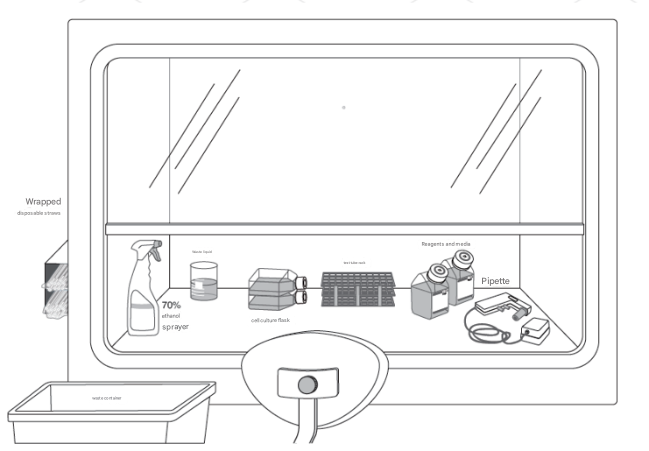
A basic workbench layout suitable for right-handed workers. Left-handed staff can adjust the placement of items on the workbench accordingly (source network)
The placement of items in the clean bench or safety cabinet generally follows the following right-handed trial habits, and can be changed accordingly according to the addition of items in special experiments.
1) Place a cell culture vessel in an open area in the middle of the bench;
2) Place the pipette in a place with easy access to the front right;
3) The reagent and culture medium are placed in the right rear for easy suction;
4) The test tube rack is placed in the middle and rear part for fixing other reagents;
5) A small container is placed in the left rear to hold the waste liquid.
6. Human operation skills
1) Be careful with sterile test items, do not touch the tip of the straw or the mouth of the container, and do not operate the experiment directly above the open container. After opening the container, hold the cap with your hand and hold the bottle at an angle of about 45°, trying not to place the cap on the table with the mouth facing down.
2) Only one cell line is processed per operation, and the medium is not shared even if the medium is the same, to avoid accidental mix-ups or contamination between cells. After the experiment is completed, take the experimental items out of the workbench and wipe the aseptic countertop with 75% alcohol. The operation interval should be more than 10minutes after the sterile workbench is operated before the next cell line is operated.
3) Centrifuge tubes, cryopreservation tubes and other containers should be marked with an alcohol-resistant marking pen with the name of the contents, the date of operation, and the name of the operator. If you are subculturing cells, you need to indicate the current number of generations and the number of plates in the same generation.
3. Cell compartment sterilization program
The cell room mainly does a good job of cleaning and disinfection, and Xiaoai has summarized the types and principles of disinfection reagents commonly used in the cell room for everyone to understand.
Types of fungicides and their principle of action
|
class |
How it works |
peculiarity |
|
Alcohol bactericides |
The antimicrobial principle of ethanol is to denature proteins |
volatile and short action time; Irritation; flammability |
|
Chlorine-containing bactericides |
The proteins of the bacteria and viruses are denatured through the extremely strong oxidation of the new ecological oxygen, which kills pathogenic microorganisms. |
Irritation; Corrosive |
|
Aldehyde bactericides |
Amino- and sulfto-alkylation of proteins inactivates microorganisms |
Irritation; carcinogenicity |
|
Peroxide-based biocides |
The proteins that make up bacteria are destroyed by the strong oxidation of hydroxyl groups |
Irritation; Corrosive |
|
Iodine-containing bactericide |
It destroys the active genes of the pathogen plasma protein by oxidation and binds to the amino group of the protein to denature and precipitate |
Irritation; Corrosive |
|
Phenolic bactericides |
Phenols can cleave and penetrate the cell wall, allowing bacterial proteins to agglutinate and precipitate |
Irritation; It is easy to make rubber products brittle and hard |
|
Ethylene oxide biocide |
Ethylene oxide undergoes an alkylation reaction with protein molecules |
flammable and explosive; Highly toxic |
|
Biguanides and quaternary ammonium bactericides |
Destroy the cell membrane of bacteria, increase the permeability of bacterial cytoplasmic membrane, and extravasate the cytoplasmic material of the bacteria |
Non-irritating; Non-corrosive; Biodegradable |
1. Sterilization program for instruments and equipment and object surfaces
The main conditions suitable for microbial proliferation are warm and humid places, such as incubators, water trays, water baths, etc., and the commonly used fungicides are as follows:

Incubator biocide (abs9372-480mL)
Incubator fungicide features:
Broad-spectrum efficient: Specifically designed for CO removal2Microbial contamination such as bacteria, fungi and mycoplasma in the incubator;
High safety: no irritation, no corrosion, no volatile;
Easy to use: direct spraying can be done, saving time and effort.
Usage:
1. After removing the cells, spray an appropriate amount directly on the partition and inner wall of the cell culture incubator, or pour out a little, soak the absorbent cotton ball and wipe it for use;
2. It is recommended to treat it once a week, and the effect is better when used with the sterilizer in the incubator water tray. In case of pollution outbreak period, such as the rainy season, the dosage can be appropriately increased.
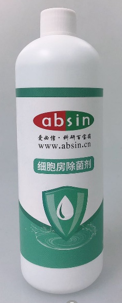
Cell compartment bactericide (abs9373-480mL)
Features of cell compartment fungicide:
It has a strong antibacterial function, which can be used for the pollution control of the cell room, and can effectively prevent the pollution of the cell by removing the bacteria, fungi and their spores in the cell room, so as to reduce the waste of manpower, financial resources and time caused by cell pollution.
Usage:
1. Spray directly on the dead corners, walls and spaces of the cell room, or pour out a little, soak the absorbent cotton ball and wipe it for use. It is recommended to treat it once a week, and the effect is better when used with ultraviolet light.
2. It is recommended to use 5-8mL per cubic meter (m³), such as 10m2The recommended dosage for a room with a height of 3 m is 150mL. In case of pollution outbreak period, such as the rainy season, the dosage can be appropriately increased. If there is mold growth on the indoor wall, spray it on the surface of the wall or wipe it with a soaked cotton ball.

Water Tray Bacteriostatic Agent (abs9374-20mL)
Characteristics of water tray bacteriostatic agent:
It is used to disinfect the water tray in the incubator, which can effectively kill bacteria, spores, mycoplasma, fungi (yeast, mold) and viruses; Innocuity; Non-corrosive to stainless steel; Non-volatile.
Usage:
1) It is recommended to systematically clean and disinfect the incubator water tray once a week.
2) Dilute 100 times to use, that is, add 10mL of water pan bacteriostatic agent to 1 liter of water.
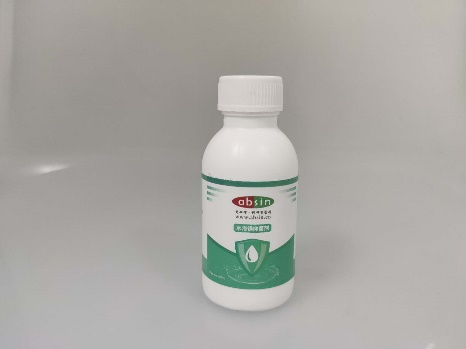
Water Bath Antibacterial Agent (abs9371-100mL)
Characteristics of bacteriostatic agent in water bath:
It is used to disinfect water baths, which can effectively kill bacteria, spores, mycoplasma, fungi (yeast, mold) and viruses.
Usage:
1) It is recommended to systematically clean and disinfect the water bath once a week.
2) Dilute 500 times to use, that is, add 2mL of water bath antiseptic agent to 1 liter of water.
2. Cell room air disinfection method
Air pollution should not be underestimated, aerosol pollution is also a common way of pollution in cell rooms, Xiaoai sorted out the common air disinfection methods as follows:
|
Sterilization method |
How it works |
peculiarity |
|
Ultraviolet lamp sterilization |
The wavelength at 260 nm has the strongest bactericidal power, and ultraviolet light acts on cellular DNA |
poor penetration; There are dead ends; Carcinogenic |
|
Ozone sterilization |
The strong oxidation of a single oxygen atom decomposed by ozone destroys the cell membrane proteins of bacteria |
Sterilization thoroughly; Low residue; It is more expensive |
|
Air Filtration (Constant Temperature and Humidity Device) |
Membranes with different pore sizes are used one at a time to filter out the microorganisms |
Sterilization thoroughly; Innocuity; It is more expensive |
3. Disinfection method of cell room floor
The ground is the most commonly ignored place in the cell room, and usually, the microbial contamination brought by the soles of the feet is also one of the key factors leading to the outbreak of cell room pollution.
|
Sterilants |
How it works |
peculiarity |
|
84 disinfectant (Sodium hypochlorite) |
Hypochlorous acid, the hydrolysate of sodium hypochlorite, is further decomposed The formation of new ecological oxygen [O], the strong oxidation of new ecological oxygen Denature the proteins of the bacteria and viruses |
Sterilization thoroughly; Low residue; There is corrosion; It is easily released when mixed with ammonia or acid (e.g. toilet cleaner). Toxic chlorine gas |
|
The new Jieer is extinguished (Benzalkonium bromide) |
Quaternary ammonium salt disinfectants belong to cationic surfactants, It can adsorb anionic bacteria and destroy the cell membrane of bacteria, Increases bacterial cytoplasmic membrane permeability. |
It can kill common bacteria and fungi; low irritation; Non-corrosive; |
|
Come to Sur (Cresol) |
Phenols can cleave and penetrate the cell wall, making the thallus protein Agglutination and precipitation, rapid cell killing. |
It can kill common bacteria, fungi, and strong irritation. It is easy to make rubber products brittle and hard |
That's all for today's explanation, if you have experimental questions, welcome to join the group to communicate!
Note: Some of the pictures in the article are from the Internet and are for reference only.
This issue is recommended by Xiaoai
|
Catalog number |
name of article |
specification |
Lead time |
|
abs9246 |
Penicillin-streptomycin-amphotericin B mixture solution (100× triclonal antibody) |
100mL |
Spot |
|
abs42018967 |
Gentamicin sulfate solution (10 mg/mL) |
10mL |
1-2 weeks |
|
abs9371 |
Water bath bacteriostatic agent |
100mL |
Spot |
|
abs9372 |
Incubator biocide |
480mL |
Spot |
|
abs9373 |
Cell compartment bactericides |
480mL |
Spot |
|
abs9374 |
Water pan bacteriostatic agent |
20mL |
Spot |
Absin provides antibodies, proteins, ELISA kits, cell culture, detection kits, and other research reagents. If you have any product needs, please contact us.
|
Absin Bioscience Inc. Email: worldwide@absin.net |
 Follow us on Facebook: Absin Bio Follow us on Facebook: Absin Bio |




